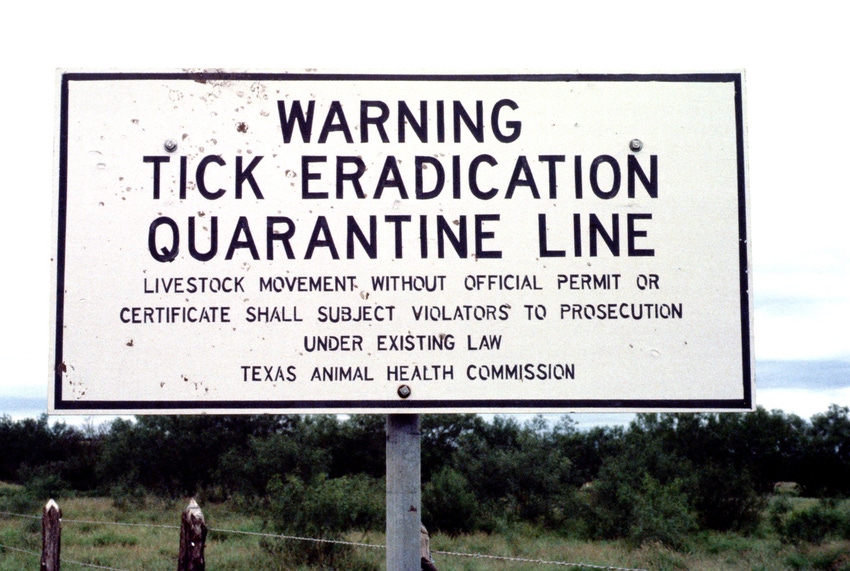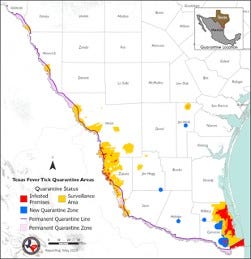All infested premises quarantined, while state and federal agencies work to inspect affected premises and surrounding areas.
May 18, 2020

The Texas Animal Health Commission (TAHC) and the U.S. Department of Agriculture's Cattle Fever Tick Eradication Program (CFTEP) announced May 15 that they have seen an increase in fever tick confirmations outside of established quarantined areas in south Texas.
"Fever ticks have been found on cattle outside of the established quarantine areas in Cameron, Hidalgo, Jim Wells, Jim Hogg and Willacy counties" in Texas, TAHC executive director Dr. Andy Schwartz said. "Many of these counties had pre-existing fever tick quarantine areas, but these newly identified premises are outside of those."
All of the infested premises have been quarantined, and TAHC staff are working alongside CFTEP to systematically inspect the premises and the surrounding areas to identify the potential span of the infestation, the agency said in an announcement.

“When we find new premises infested with fever ticks, we always conduct an investigation to determine the source of the ticks and if there has been additional spread,” Texas state epidemiologist Dr. Susan Rollo said. “We are still in the beginning stages of the investigation process; however, initial indications suggest the investigation will be extensive.”
When fever ticks are discovered on a premise, the location is quarantined. Once quarantined, the cattle and other susceptible livestock are prescribed a treatment program until fever ticks are eradicated from the land. Livestock on the infested premises can still be sold and moved off the premises as long as they are inspected and treated before movement, TAHC said.
"We ask that livestock producers help us in protecting the nation from fever ticks by being proactive when purchasing cattle from counties with known fever tick infestations,” Schwartz said. “TAHC and USDA-CFTEP operate public dipping vats along the Texas-Mexico border and in a few south Texas counties where producers can voluntarily take their cattle to be treated before returning home.”
Voluntary treatment and inspection of cattle purchased in south Texas will both increase surveillance for cattle fever ticks and eliminate the need for tracing exposed animals, TAHC said.
For a list of public vat information, visit: www.tahc.texas.gov/animal_health/feverticks-pests/TXDippingVatMap.pdf.
At present, TAHC said approximately 1 million acres are under various types of fever tick quarantine outside of the permanent quarantine zone. To learn more about the quarantine areas, visit http://www.tahc.texas.gov/animal_health/cattle/#ticks.
“When producers observe ticks on their livestock, it is imperative that they contact their local TAHC livestock inspector or region office, USDA inspector, private veterinarian or local Texas A&M AgriLife Extension office to arrange for collection and submission of tick samples to the TAHC laboratory in Austin,” Schwartz said. “This extra surveillance protects the Texas cattle industry.”
Cattle fever ticks, known scientifically as Rhipicephalus annulatus and Rhipicephalus microplus, are a significant threat to the U.S. cattle industry, TAHC said, explaining that these ticks are capable of carrying the protozoa Babesia bovis or Babesia bigemina, which cause the disease commonly known as cattle fever. The babesia organism attacks and destroys red blood cells, causing acute anemia, high fever and enlargement of the spleen and liver, ultimately resulting in death for up to 90% of susceptible naive cattle.
You May Also Like


.png?width=300&auto=webp&quality=80&disable=upscale)
